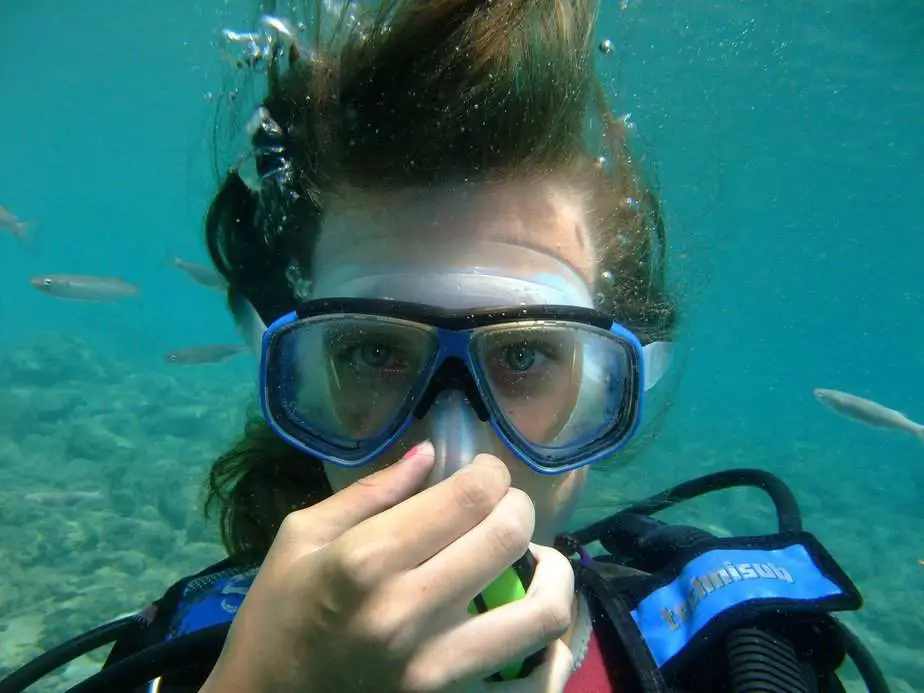If you’ve felt ear pain while scuba diving, you’re not the only one. In fact, ear problems are perhaps the most common reason why many scuba divers give up on this activity. If you really like scuba diving but the constant ear pain is making it a nightmare to enjoy it, then you will be happy to learn that there are solutions to fix ear pain while diving.
With that said, many people wonder if one such solution is to wear earplugs to keep the inside of the ears dry, preventing an ear infection from occurring. However, as you’ll learn in this article, wearing regular earplugs while scuba diving is dangerous and must NOT be done. Instead, there are special scuba diving earplugs can be used to prevent equalization problems and ear infections.
What really causes ear pain?
While ear infections are a cause of ear pain, the more immediate ear pain problems scuba divers experience have more to do with water pressure. During the descent, the external surface of the eardrum is the first to experience the effects of the increase in pressure.
As this occurs, the pressure would normally equalize in the inner surface of the eardrums by traveling through the Eustachian tube to open. However, if the Eustachian tube is not open, then the eardrum is subjected to the rising pressure inside, leading to ear pain and inflammation.
Some recreational divers who don’t dive very deep may be able to withstand the ear pain at low depths because the water pressure is not intense enough. However, this is very uncomfortable and may eventually rupture the eardrum. A ruptured eardrum can cause dizziness, vomiting, pain, and hearing loss.
Divers who don’t know how to equalize will not be able to dive further, and earplugs will not be able to solve this equalization problem. Earplugs can, however, prevent an ear infection known as Swimmer’s Ear which can occur when the outer ear is exposed to water, or water is trapped in the ear canal for a prolonged period of time. Again, you should be wearing a special type of earplug known as vented earplugs instead of using a traditional one which does nothing for equalization.
Not everyone experiences ear pain when diving; usually it’s straightforward to equalize by simply pinching the nose and exhaling. But for divers who have problems equalizing their ears, each dive can be quite stressful not knowing whether you will be able to deal with your ear pain or not.
If you’re having equalization problems while diving, you should signal to your dive buddy that you’re going to resurface and abort the dive.
Why standard earplugs are NOT the solution

They prevent you from equalizing your ears
When you descend while diving, the increasing water pressure will put a strain on your ears and sinuses. If they are not cleared, you can suffer a painful injury known as a “squeeze.” When you wear regular earplugs, a small amount of air will be trapped in the space between the earplug and your eardrum.
Like your sinuses and ears, the air trapped by the earplugs will also get compressed while descending, causing the earplug to get pushed further into your ear canal. Your plugged up ear canal will prevent you from equalizing your ear correctly, and having the earplug lodged deep inside your ears is painful as well.
Even if you manage to reach your maximum depth without equalizing your ears, you’re still in danger. On your ascent, the trapped air pocket that has now been squeezed to such a small space will rapidly expand. If you hadn’t perforated your eardrums yet, you definitely will on the ascent with earplugs in.
They block sound
Gasp! Earplugs do exactly what they were designed to do? How dreadful!
In all seriousness, this is a clear example of why you sometimes shouldn’t use a product for something it isn’t designed for. While it’s difficult to speak underwater, and many noises sound muffled anyways, there is still a benefit to being able to hear all the noises.
For instance, even if you can’t hear speech clearly, perhaps your dive buddy is trying to get your attention by tapping on their tank. It’s possible to alert divers from a reasonable distance to potential dangers or something cool to look out. With earplugs in, you may miss out on this warning.
When you’re familiar with your dive buddy’s signals, you can even tell the urgency of the sound by how gently or urgently they rattle or bang. Even if you could somehow safely wear standard earplugs underwater, they prevent you from using one method of communication which is a major detriment.
What are these “special” scuba diving earplugs?
As we have alluded to many times now, there are indeed “special” earplugs which are designed for diving, and they are known as vented earplugs. The most popular, field-tested vented earplugs available are No products found.. These vented earplugs are made from a soft yet durable hypoallergenic plastic called Dynaflex.
Vented earplugs are safe for scuba diving because they have a valve built-in that lets air and water out from the ear canal to allow equalization to occur. Sound can also be more easily heard because of the vent valve so you can still pick up on any signals.
Benefits of vented earplugs
Divers who are worried about experiencing ear pain due to ear infection or not being able to equalize will find that vented earplugs can help prevent them from occurring.
First, the plug’s snug fit prevents any water-borne debris from reaching the ear, and any water that does seep in stays warm and mostly static instead of constantly flushing in and out of the ear canal. These factors will stop ear infections from occurring.
Second, even though the vent lets water in and out of the ear canal at a slower rate, it also prevents abrupt pressure changes from reaching the eardrum. The end result is a smoother experience where any potential ear pain is kept to a minimum, and equalization is much easier.
Downsides of vented earplugs
Much like a wetsuit, earplugs are only as effective as the fit is snug. You must get an earplug within the correct size range otherwise it will be ineffective. Furthermore, even if you have the size correct, you need to make sure they fit into the shape of your ear for them to work.
Getting the earplugs to fit perfectly before you do a dive can be a little iffy. Perhaps one ear is stubborn and won’t seem to hold it in place. Furthermore, since earplugs are so small, they are easy to lose or misplace.
Another downside is that the plug valve can get blocked. Should this happen during the descent, then you will run into the same problems as a standard earplug and will have to remove the plugs in order to continue diving.
If an earplug doesn’t fit properly, they can just fall out during a dive. Most diving earplugs have a connected wire so that you won’t lose them completely, but putting it back in can be a hassle.
Even though we said it’s much easier to hear with vented earplugs compared to standard earplugs, at the end of the day they are still earplugs, so it will be more difficult to hear sounds.
Lastly, once you’re finished with your dive, you will need to thoroughly clean it after use and store it which is just an additional post-dive chore.
Do I need vented earplugs?
Are you having trouble with ear infections or equalizing your ears? Then give vented earplugs a try. They are affordable and have the potential to make diving enjoyable for you again. Remember to only wear earplugs designed for diving and not standard earplugs.
Tips to prevent ear pain while scuba diving
Even with vented earplugs inserted, if you don’t know the proper steps to protect your ears while diving, then you will still suffer. In this section, we’ll go over the safety guidelines to protect your ears underwater.
Equalize early and often
All divers must equalize their ears. The question for beginners is when? You must remember to equalize as soon as you begin your descent and multiple times during the descent. You may need to equalize as often as once every 3 ft (1 m) early on in the dive. Basically as soon as you feel a pressure in your ears, equalize, otherwise your ears will get blocked.
If you are having trouble equalizing your ears, stop descending until you can. You may even need to ascend a little bit to decrease the pressure and try equalizing again. Try going up even higher if your ears just aren’t equalizing. If you cannot equalize your ears, just resurface. Never try to force equalization or endure the pain; just call it before it reaches that point.
Find an equalization that works for you
Thus far, we’ve been making the assumption that you know how to equalize your ears using the Valsalva maneuver, which is when you pinch your nose and then exhale. Unfortunately, this method doesn’t always work. Thankfully, there is more than one way to skin a cat, or in this case, to equalize.
Below are some alternate equalization methods that may work for you:
- Toynbee maneuver: Hold your nose and swallow simultaneously.
- Yawn and swallow: Thrust your lower jaw forward, open your mouth slightly, and swallow while keeping your lips pursed around the regulator.
- Head tilt: Tilt your ear upwards to try to stretch the openings of the eustachian tubes.
There are a few other equalization techniques which you can read about here.
Don’t dive with a cold or congestion
Even ignoring the fact that your body is in a weakened state, when you have a cold or a congestion you will find it difficult, if not impossible, to equalize your ears while scuba diving.
Should you manage to dive to depth without ear pain, you can also experience a reverse-block on the ascent. Essentially, the air in the ears and sinuses get trapped due to the congestion and this can be just as painful and damaging as if you didn’t equalize.
Furthermore, keep in mind that any over-the-counter cold medications may cause side effects like drowsiness, and they may not be effective at treating your illness. Only dive with medications if they have been specifically prescribed to you by a scuba doctor, such as medicine for asthmatics.
Rinse your ears after a dive
After a dive, remember to rinse out your ear canal using fresh drinking water. If you aren’t wearing vented earplugs, then there may be some salt or debris left in the canal that can cause inflammation and infections.
Even after you’ve finished washing your ears, make sure to dry them properly. You can use an ear dryer or ear drops to quickly dry the water so that it doesn’t cause swimmer’s ear.
Parting Words
As you now know, scuba divers should never dive with standard earplugs. To be honest, even vented earplugs aren’t the perfect solution either seeing as how there are quite a few downsides, but if you really want to wear earplugs while scuba diving, then those are your best bet.
If you have sensitive ears or have suffered ear pain in the past, then at least give vented earplugs a try. Despite being so inexpensive, there is a possibility that they could be the solution to your ear pain, and that makes them invaluable.
Last update on 2024-07-12 / Affiliate links / Images from Amazon Product Advertising API


